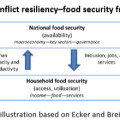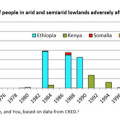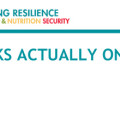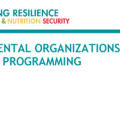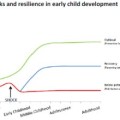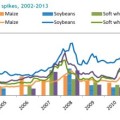Pastoralists in the Horn of Africa face five big challenges to their resilience: They are losing land to farmers, irrigation, tourism, and land investments by outside investors. Conflict and violence have disrupted livelihoods and markets and increased vulnerability during drought. Population growth has put heavy pressure on land resources. Among pastoralists, there are large differences >> Read more
Day One in Photos
Highlights from Conference Brief 3: Building resilience to conflict through food security policies and programs
Food insecurity and conflict often go hand-in-hand: a lack of food can ignite conflict and conflict can result in food shortages and unavailability. What’s more, the scope of the problem is far reaching, as more than one and a half billion people live in areas impacted by conflict. In their 2020 Conference Brief, Building Resilience >> Read more
Highlights From Conference Briefs 12 and 14: Building Resilience In The Face Of Conflict
In the past few decades, food-related challenges like climate change and food and nutrition security coupled with other social and political issues have led to conflict and unrest on both the national and regional scale. Climatic shocks are considered to be one of the root causes of conflict, especially in resource-constrained settings. At the same time, conflicts tend to exacerbate existing vulnerability, leading to poverty‐conflict traps at the household, community, and national levels. In their conference brief, Margherita Calderone, Derek Headey, and Jean-François Maystadt review the research about the impact of climate change >> Read more
Highlights from Conference Brief 5: Are Shocks Actually on the Rise?
From extreme weather events to rising and highly volatile food prices, poor and vulnerable populations are subject to a bevy of shocks that threaten their basic food and nutrition security. In the face of global climate change and other recent food price spikes, it seems to many that such events are occurring more and more >> Read more
Highlights from 2020 Conference Brief 7: Nongovernmental organizations’ approaches to resilience programming
Stories of nongovernmental organizations (NGOs) providing emergency relief in the aftermath of natural disasters and other humanitarian crises are familiar parts of the news. When NGOs such as CARE or Mercy Corps support medical services in South Sudan or bring food to people affected by Typhoon Haiyan in the Philippines, we are not surprised. Less >> Read more
Highlights from Conference Brief 4: Local sources of resilience
Before government programs and international aid efforts, people coped with disasters, famine, conflicts, and other shocks by coming together as a community and relying on their networks—in other words, using social capital. Social capital, in the form of community-based organizations and social networks, has traditionally played an important, but largely unexplored, role in building resilience. >> Read more
Highlights from Conference Brief 18: Strengthening the links between resilience and nutrition
In the field of food policy, nutrition and resilience are strongly interlinked conceptually—and now Charlotte Dufour, Domitille Kauffmann, and Neil Marsland are trying to bind the two much more tightly in practice. Resilience, according to the Food and Agriculture Organization of the United Nations (FAO), is “the ability to prevent disasters and crises as well >> Read more
Highlights from Conference Briefs 10, 17 and 19
There is a wide recognition that building the resilience of the rural poor—the most vulnerable group—requires helping the affected recover from various shocks, such as weather and nutritional shocks.
Highlights from Conference Brief 16: Building a resilient global food system by lowering food price spikes and volatility
Why should we be concerned about volatility and spikes in global food prices, particularly since they have subsided in recent years?


